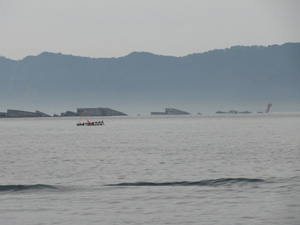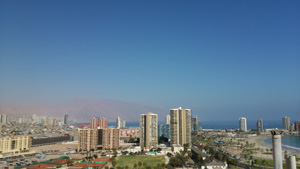Top>Research>Town planning to prepare for disasters in coastal areas
 Index
Index
Town planning to prepare for disasters in coastal areas
Taro Arikawa
Professor, Faculty of Science and Engineering, Chuo University
Areas of Specialization: Coastal Engineering, Tsunami Disaster Prevention.
Coastal development from the post-war era until the Great East Japan Earthquake
The development of coastal areas during the post-war era began with the enactment of the Coast Act in 1956. Storm surge damages caused by a large number of typhoons were interfering with Japan’s post-war recovery. Especially typhoon No. 13 of 1953 led to extensive damage, and Japan was again struck in 1959 after the enactment of the Coast Act. This was typhoon No. 15, known as the Isewan Typhoon, which tragically led to over 5,000 deaths. After so much damage, the key objective of the enactment of the Coast Act was therefore protection. At that time, the so-called “line shore protection system” was carried out and coastal levees and revetments were installed, with the objective of protecting the hinterland. When this was almost accomplished, the adverse effects of constructing man-made structures such as coastal levees and breakwaters emerged clearly. For example, coastal levees reduced people’s access as they lost interest in the coast. Alternatively, there were problems including deterioration of the bay environment and advanced erosion on the outskirts of sandy beaches due to fixed structures such as breakwaters. Methods of protection were therefore switched from the simple protection system to the integrated shore protection system that considered hydrophilicity and the coastal environment. The Coast Act was amended in 1999 to make “protection, environment and utilization” its primary purposes.
Consequences of the Great East Japan Earthquake

Kamaishi port sea wall struck by tsunami from the Great East Japan Earthquake
Civil engineering structures, especially concrete structures, can maintain their strength for some time. This period is called the service life, and is believed to be around 50 to 100 years. Because of this, around 2009, after which 50 years have passed since the Isewan typhoon, a big problem arose. How are existing protective facilities maintained? This question’s importance comes from the fact that Japan is surrounded by the sea on all four sides with approximately thirty thousand kilometres of coastline. Even if facilities were repaired in sequence, this would still require a substantial amount of money. Amidst all this, in 2011 the Great East Japan Earthquake occurred. Facilities like the Kamaishi Bay breakwater which had been completed over several decades were destroyed in a moment by the enormous tsunami. The extensive damage to the hinterlands was shocking, and civil engineers suddenly felt powerless. From here, there was much discussion of the method to protect facilities as well as the nuclear plants for rehabilitation and reconstruction purposes. The discussion turned into social and political issues which included oppositions to protecting the facilities. Even now the discussion continues, and from a perspective of coastal protection, we are facing a serious fork in the road.
Protective policy decisions and challenges that remain
In such conditions, the government proposed that it is important to not only protect us from tsunami based on conventional tangible measures, but also implement tangible and intangible measures as two pillars. This was because with the current knowledge, building coastal levees that stop overflowing is considered difficult, regardless of how far inland the high tsunami came, not to mention the economic burden of building them. While approaching this method, a two-stage configuration for disaster prevention and mitigation was also launched. The first stage tsunami height reflects the height of protection facilities based on the conventional idea of eliminating damage at the hinterland from tsunami lower than first stage height. The second stage tsunami height is the measurement to create evacuation plans and still protect lives when we are hit by tsunami larger than the first stage height. The issue of town planning remained while considering the possibility of overflow in the hinterland if a tsunami hit higher than the second stage height. Among all of this, the Flood Protection Law was amended in May 2015 that clearly described disaster prevention measures focusing on disaster mitigation and preventative maintenance.
Town planning in coastal areas

Frequently struck by tsunami, their coastal townscape of Iquique, Chile shows disaster protection measures.
It is clear that measures for disaster protection need to be developed together with regional planning, despite its method not yet being systemised and most likely will take time to establish. The social, economic, and psychological issues need a comprehensive solution to tackle the problems of physics, civil and architectural engineering, including finding the degree of tsunami that buildings and bridges can withstand, developing measures for emergency alerts and evacuations, how to perform post-disaster restorations quickly, and what is the largest tsunami height range. Today, there are more cases of large typhoons, storm surges and heavy rainfall influenced by climate change that have exceeded past records. Town planning involves the understanding of natural external forces and careful research of their phenomena. I wish to contribute to the continuous process of town planning from the stages of developing full protection from natural external forces, conducting disaster prevention through integrated intangible measures, and systemizing the protection method as comprehensive knowledge for the future.
Related Links:
- Taro Arikawa
Professor, Faculty of Science and Engineering, Chuo University
Areas of Specialization: Coastal Engineering, Tsunami Disaster Prevention. - Taro Arikawa graduated from the Department of Civil Engineering, Faculty of Engineering, University of Tokyo in 1995.
He completed the Doctoral Program in the Department of Civil Engineering, Graduate School of Engineering, University of Tokyo in 2000. He is a Doctor of Engineering.
He Joined the Department for Transport Port and Harbor Research Institute in 2000, which was later renamed the Independent Administrative Institution Port and Airport Research Institute.
He assumed his current position in April 2015. - After the 2004 earthquake and tsunami off the coast of Sumatra, while vigorously performing tsunami damage investigations home and abroad, he combined field, experimental and numerical calculations, and continued to research the phenomena.
In particular, he engages in the clarification of the mechanism of protection facilities’ destruction, and research into their persistence and effects. Arikawa is the author of “Dousuru?! Kyodai Tsunami (What should we do?! Huge Tsunami)” (Nippon Hyoron Sha)
- Research Activities as a Member of Research Fellowship for Young Scientists (DC1), Japan Society for the Promotion of Science (JSPS) Shuma Tsurumi
- Important Factors for Innovation in Payment Services Nobuhiko Sugiura
- Beyond the Concepts of Fellow Citizens and Foreigners— To Achieve SDGs Goal 10 “Reduce Inequality Within and Among Countries” Rika Lee
- Diary of Struggles in Cambodia Fumie Fukuoka
- How Can We Measure Learning Ability?
—Analysis of a Competency Self-Assessment Questionnaire— Yu Saito / Yoko Neha - The Making of the Movie Kirakira Megane









